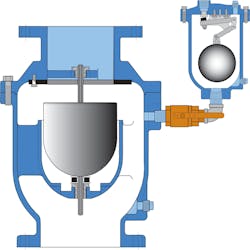The presence of air in a pipeline and its impact on operations is one of the most misunderstood aspects of the water and wastewater industry. For example, many operational problems are blamed on inadequate thrust blocking or improper pipeline bedding; instead, the problem is actually caused by failure to de-aerate the line. The use of automatic air valves will properly de-aerate the pipeline and safeguard it from air-related problems.
There are three basic types of air valves standardized in American Water Works Association (AWWA) Standard C512-15: “Air-Release, Air/Vacuum, and Combination Air Valves for Water and Wastewater Service.” Understanding each valve’s function and limitations can aid in locating and sizing them for each application and safeguarding pipeline integrity.
Air release valves, the likely best-known valve, are typically furnished in sizes from 1/2 to 3 inches. They have a small precision orifice to release air under pressure continuously during pipeline operation. The air release valve has a float that senses the presence of air and a linkage mechanism that gives the float a mechanical advantage in opening the orifice under full pipeline pressures. These valves, however, have a limited capacity for admitting and exhausting air because of their small orifice. For this reason, most pipeline locations require both air release and air/vacuum valves to exhaust and admit large volumes of air.
An air/vacuum valve is installed downstream of pumps and at high points to exhaust large volumes of air during pump start-up and pipeline filling. The valve will also admit large volumes of air to prevent a vacuum condition from occurring in the pipeline and to allow for draining. A float in the valve rises with the water level to shut off the valve when the air has been exhausted. When pressure drops due to draining, line breakage, or column separation, the float will drop to allow air to reenter the pipe.
It is important to note that under normal operation, the float is held closed by the line pressure and will not relieve accumulated air. An air release valve is needed to relieve air during system operation.
The combination air valve combines the functions of both the air/vacuum and air release valves and is an excellent choice for high points. A combination air valve contains both a small air release orifice and a large air/vacuum port in one assembly. On smaller valves, the float and lever mechanism are contained in a single body design. On larger sizes, a dual body design consisting of an air release valve piped to an air/vacuum valve is furnished.
Single body units have the advantage of being more compact and typically less costly. Dual body units are advantageous for air release valve sizing and maintenance because the air/ vacuum valve is still in operation while the air release valve is isolated and under repair. By combining various sized air release and air/vacuum valves, a dual body combination valve can be made for almost any application. Some designers use only combination air valves on a pipeline because all air valve functions are included and a mistake in field installation will not leave the pipeline unprotected.
When air is allowed to accumulate in pressurized pipelines, efficiency is sacrificed, and serious damage can occur. Removal of air from a pipeline will not solve all surge and efficiency problems. However, the elimination of air can solve one of the most common causes of these problems. Air valves are a cost effective, reliable method of improving efficiency and solving air related surge problems. WW
About the Author: Diane Meyer is director of marketing at Val-Matic Valve & Manufacturing Corporation and serves on the Water and Wastewater Equipment Manufacturers Association (WWEMA) Board of Directors and Executive Committee as Vice Chair. WWEMA, a non-profit trade association formed in 1908, represents many of the most prominent and influential water and wastewater technology manufacturers working together to shape the future of the industry. Learn more at www.wwema.org.
Published in WaterWorld magazine, November 2021.




